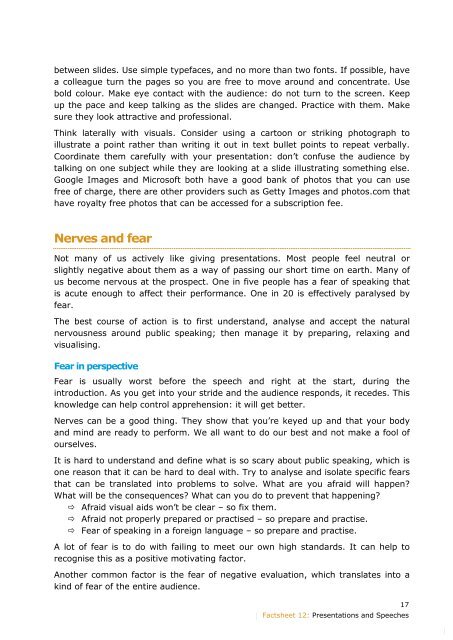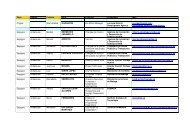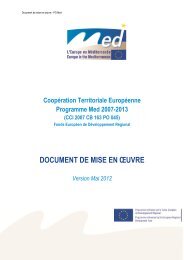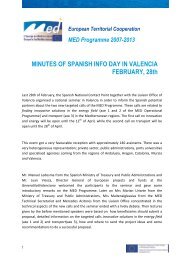MED Communication Handbook - Programme Med
MED Communication Handbook - Programme Med
MED Communication Handbook - Programme Med
You also want an ePaper? Increase the reach of your titles
YUMPU automatically turns print PDFs into web optimized ePapers that Google loves.
etween slides. Use simple typefaces, and no more than two fonts. If possible, have<br />
a colleague turn the pages so you are free to move around and concentrate. Use<br />
bold colour. Make eye contact with the audience: do not turn to the screen. Keep<br />
up the pace and keep talking as the slides are changed. Practice with them. Make<br />
sure they look attractive and professional.<br />
Think laterally with visuals. Consider using a cartoon or striking photograph to<br />
illustrate a point rather than writing it out in text bullet points to repeat verbally.<br />
Coordinate them carefully with your presentation: don’t confuse the audience by<br />
talking on one subject while they are looking at a slide illustrating something else.<br />
Google Images and Microsoft both have a good bank of photos that you can use<br />
free of charge, there are other providers such as Getty Images and photos.com that<br />
have royalty free photos that can be accessed for a subscription fee.<br />
Nerves and fear<br />
Not many of us actively like giving presentations. Most people feel neutral or<br />
slightly negative about them as a way of passing our short time on earth. Many of<br />
us become nervous at the prospect. One in five people has a fear of speaking that<br />
is acute enough to affect their performance. One in 20 is effectively paralysed by<br />
fear.<br />
The best course of action is to first understand, analyse and accept the natural<br />
nervousness around public speaking; then manage it by preparing, relaxing and<br />
visualising.<br />
Fear in perspective<br />
Fear is usually worst before the speech and right at the start, during the<br />
introduction. As you get into your stride and the audience responds, it recedes. This<br />
knowledge can help control apprehension: it will get better.<br />
Nerves can be a good thing. They show that you’re keyed up and that your body<br />
and mind are ready to perform. We all want to do our best and not make a fool of<br />
ourselves.<br />
It is hard to understand and define what is so scary about public speaking, which is<br />
one reason that it can be hard to deal with. Try to analyse and isolate specific fears<br />
that can be translated into problems to solve. What are you afraid will happen?<br />
What will be the consequences? What can you do to prevent that happening?<br />
� Afraid visual aids won’t be clear – so fix them.<br />
� Afraid not properly prepared or practised – so prepare and practise.<br />
� Fear of speaking in a foreign language – so prepare and practise.<br />
A lot of fear is to do with failing to meet our own high standards. It can help to<br />
recognise this as a positive motivating factor.<br />
Another common factor is the fear of negative evaluation, which translates into a<br />
kind of fear of the entire audience.<br />
17<br />
� Factsheet 12: Presentations and Speeches<br />
�








